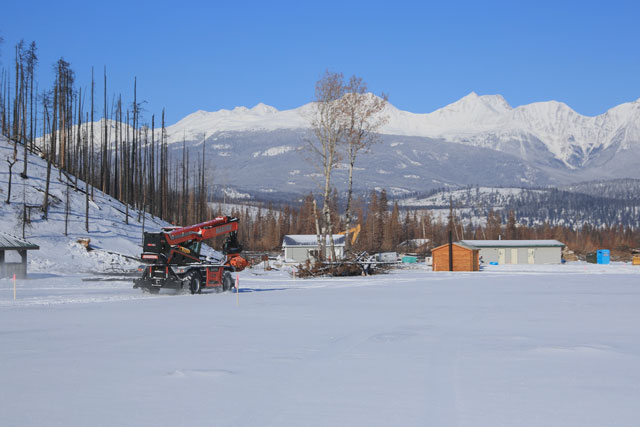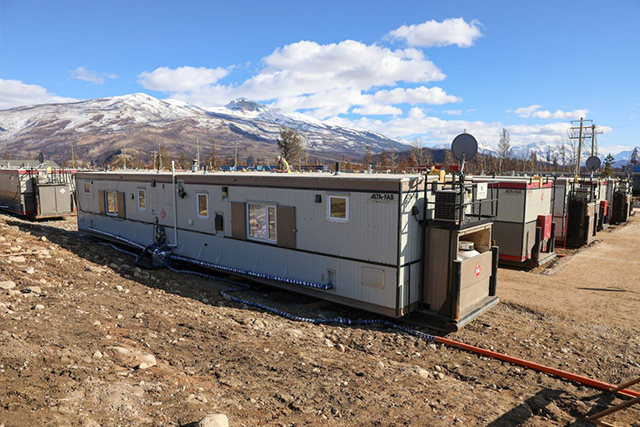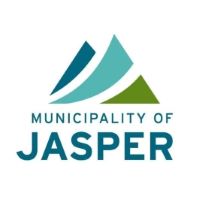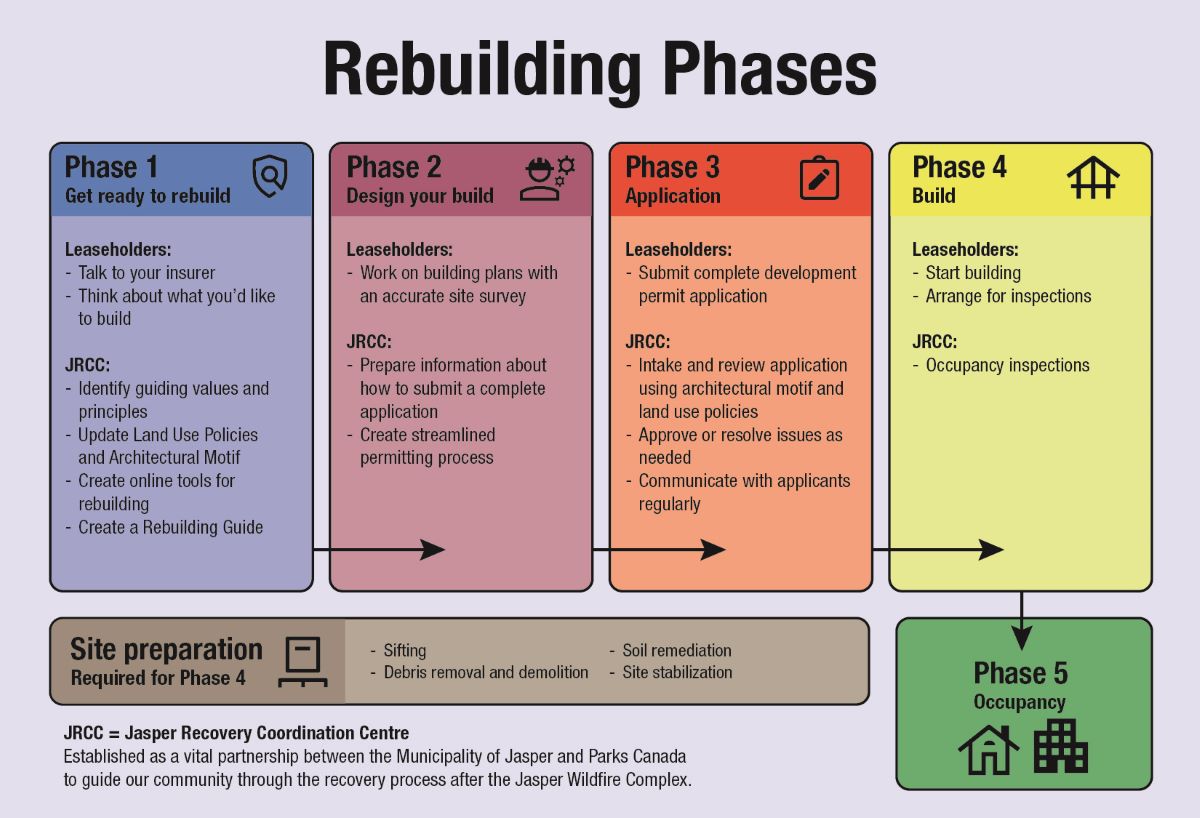
Photo: March 5, 2025
Jasper recovery
Jasper National Park
Parks Canada is committed to Jasper’s recovery from the 2024 wildfire. Find clear, accurate information on rebuilding and how Parks Canada is supporting the process. This site is here to guide you every step of the way. Updates are ongoing as recovery progresses.
The Jasper Recovery Coordination Centre
The Jasper Recovery Coordination Centre (JRCC), led by Parks Canada and the Municipality of Jasper, is focused on restoring services, supporting residents and rebuilding infrastructure to support recovery in Jasper after the 2024 Jasper wildfire. The JRCC currently has multiple working groups dedicated to debris management, rebuilding, interim housing, economic recovery and social recovery.
The JRCC was established on August 22, 2024 to ensure continued collaboration and progress as the community moves forward. Significant milestones have been achieved by working together.
NEW! Resident Camping Program application
From May 7 to October 13, 2025, Parks Canada has set aside 71 campsites to provide long-term camping as part of the interim housing strategy for Jasper. The long-term camping program is open for those affected by last year’s wildfires. The allocation of campsites will be determined by the Jasper Recovery Coordination Centre using a priority matrix tool developed for interim housing.
| Campgrounds | Services | Occupancy per site |
|---|---|---|
| Whistlers | 20 sites with power, water, sewer and showers. No fire pits | Max 6 people |
| Whistlers | 31 sites with power and showers. No fire pits | Max 6 people |
| Sleepy Hollow | 20 sites with power. No showers and no fire pits | Max 6 people |
Talk to a development officer
Parks Canada and the Municipality of Jasper, through the JRCC, are working side-by-side and remain committed to assisting residents and businesses in rebuilding after the wildfire. We understand the importance of making the process to rebuild as easy as possible and are here to help. Parks Canada is committed to supporting Jasperites through each phase of recovery and rebuilding. Talk to a development officer
Interim housing
Interim housing
Parks Canada is supporting interim housing in multiple ways, including making 4.25 hectares of land available and procuring a range of interim housing units.
The site servicing of the parcels were completed November 18, 2024, and December 6, 2024. Interim housing units for Jasper started arriving on February 11, 2025, and the first wave of Jasperites moved into units at the end of February. Parks Canada is also providing and preparing Marmot Meadows, adjacent to Whistlers Campground, for interim housing units.
Parks Canada is in the process of securing higher-density interim housing solutions for the community and Parks Canada employees.
Parks Canada is providing:
- 4.25 hectares of land in town and land at Marmot Meadows and Wabasso Campgrounds.
- 100 duplexes, creating 200 units, slated primarily for within the Jasper townsite. Some units may be located in Marmot Meadows depending on space constraints within town.
- 120 single dorm-style units at Marmot Meadows, suitable for singles or couples, with shared kitchen and laundry spaces.
- 4 pre-built units (3-bedroom, 1-bedroom, and studio).
- 20 two-bedroom prefabricated units for long-term housing.

In addition to these interim housing units, 71 seasonal campsites are reserved for resident interim housing in 2025.
NEW! Resident Camping Program application
From May 7 to October 13, 2025, Parks Canada has set aside 71 campsites to provide long-term camping as part of the interim housing strategy for Jasper. The long-term camping program is open for those affected by last year’s wildfires. The allocation of campsites will be determined by the Jasper Recovery Coordination Centre using a priority matrix tool developed for interim housing.
| Campgrounds | Services | Occupancy per site |
|---|---|---|
| Whistlers | 20 sites with power, water, sewer and showers. No fire pits | Max 6 people |
| Whistlers | 31 sites with power and showers. No fire pits | Max 6 people |
| Sleepy Hollow | 20 sites with power. No showers and no fire pits | Max 6 people |
Exploring more ways to bring residents back to Jasper
Parks Canada is exploring various other ways to support interim housing and temporary accommodations. Work underway with the Municipality of Jasper, Government of Alberta and supporting agencies includes:
- making land at Wabasso Campground available for a possible contractor style camp for the rebuild workforce. This land is one area being considered as part of an initiative with the municipality to find housing solutions for recovery workforce and seasonal workers.
In addition to this, Parks Canada is continuing to work with the Municipality of Jasper to identify additional parcels of land within the townsite for interim and long-term housing.
Staff accommodations outside of town and previously identified for decommissioning have been reopened for use, and Parks Canada is collaborating with commercial operators outside the town for on-site interim housing solutions.
Procurement efforts
Government of Canada investments bolster business, housing and tourism recovery in Jasper
Government of Canada announces over $160 million for Jasper Housing, Recovery and Wildfire Response
Government of Canada Funding for 2024 Wildfire Season in Parks Canada Administered Places, including Jasper National Park Wildfire Response, Recovery and Interim Housing
Rebuilding Jasper
Rebuilding Jasper
Together, Parks Canada and the Municipality of Jasper have outlined a 5-phase approach to Rebuilding Jasper. Information on each phase is available below.
In Phase 1, the policies that apply to development in Jasper were updated using the following guiding principles: make rebuilding easier, rebuild with fire in mind, increase housing options, climate resilience, and sustainability. A summary of changes is included in the Rebuilding Guide which is now available.
Entering Phase 2, with the information you need to design your rebuild now available, planners from Parks Canada and the Municipality of Jasper are ready to meet with you to answer questions about your building design. Parks Canada is and will continue to receive rebuild applications. Together with the Municipality, we are looking at ways to streamline the application process. Updated process details will be shared at the end of Phase 2.
Key rebuild highlights
Parks Canada, in close collaboration with the Municipality of Jasper, is working hard to make rebuilding easier. Together, we’ve reviewed the permitting and development process from start to finish, leading to changes like reduced compliance deposit requirements and fewer permitting steps. A summary of improvements will be updated here more changes are made. Visit Parks Canada's Jasper development webpage for detailed requirements. For help navigating any aspect of the rebuild process please feel free to book a drop in meeting with a planner or schedule a longer session to review your unique needs.
Update February 2025 - Compliance deposit requirements have been reduced
In the past, applicants had to pay a large compliance deposit at the beginning of the permitting process. These deposits could range from $40,000 to $500,000, depending on the size of the project.
Now, applicants only need to pay a smaller deposit once they receive occupancy approval, rather than at the building permit stage. This means most homeowners won’t need to pay a deposit anymore. For commercial or larger developments, a deposit may still be required.
Compliance deposits help ensure that outstanding permit conditions like landscaping, siding, or code issues– are completed according to approved plans. Once all permit conditions are met, applicants receive their deposit back.
The new system reduces the financial burden for applicants and helps speed up the permitting process, while still ensuring the project meets conditions. This change applies across Jasper National Park, including within the Jasper townsite.
The details:
- The compliance deposit is now required at the time of conditional occupancy, not at time of building permit issuance.
- The deposit amount will be based on 15% of the value of any outstanding landscaping costs and up to 100% of the costs of other outstanding conditions, only when the total value of those outstanding conditions exceeds $50,000.
- These changes are intended to streamline permitting and reduce financial barriers for applicants.
- As a result of these changes, most residential developments will no longer need to provide large upfront financial deposits.
Update February 2025: Simplifying permitting
In the building permit process, Parks Canada has eliminated the requirement for foundation elevation checks which simplifies the permitting process by issuing a single-stage building permit.
Parks Canada previously issued building permits for projects requiring a foundation in two stages. The first stage permitted only the pouring of the foundation, and once the foundation was verified by a professional surveyor, the permit was amended to allow full construction.
What’s changed?
The new approach has eliminated the requirement for foundation elevation checks. This simplifies the permitting process by issuing a single-stage building permit, making the building process faster.
Phase 1: Get ready to rebuild
Leaseholders:
- Talk to your insurer
- Think about what you'd like to build
Jasper Recovery Coordination Center (JRCC):
- Identify guiding values and principles
- Updates Land Use Policies and Architectural Motif
- Create online tools for rebuilding
- Create a rebuilding guide
Frequently asked questions – Information on Rebuilding Phase 1: Get ready for rebuild
Introduction
Parks Canada and the Municipality of Jasper are collaborating on a phased approach to support residents and businesses who lost structures during the wildfire. Work on Phase 1 of this approach has now been completed. Updated land use policies and a Rebuilding Guide are now available.
Answers to frequently asked questions specific to Phase 1 have now been included in the Rebuilding Guide.
End of Phase 1 useful links:
- Updated Land Use Policy
- Updated Architectural Motif
- Rebuilding Guide New
- Rebuilding after the wildfire: Parks Canada changes the Town of Jasper Land Use Policy
- Rebuilding after the wildfire: Updates to Parks Canada policies will ensure community of Jasper is better prepared for future challenges while maintaining the unique character of the town
Demolition and Debris Removal Process
Q. How do I get a residential demolition and debris removal permit?
Steps for Residential Leaseholders
Step #1: Contact your insurance company. Determine who is going to do the demolition and debris removal work.
Step #2: Complete forms
If someone else is applying for a permit for demolition and debris removal on your behalf, you must sign an authorization form.
Parks Canada cannot issue a permit to a third party for your leasehold for demolition or debris removal without this authorization. Specific contractors will also have forms you need to sign.
Forms needed:
- Leaseholder Authorization Letter (PDF, 72 KB) (if someone else is applying for the demolition and debris removal permit on your behalf)
- Development Permit Application form (PDF, 199 KB) (the form needed for a demolition and debris removal permit)
Step #3: Submit Completed Forms
You, or your authorized representative submits completed forms to developpementjasper-jasperdevelopment@pc.gc.ca.
Once submitted you will receive a response as soon as possible.
Please note that this application is for the demolition and debris removal process only. Additional permits and requirements for rebuilding are also required. More information will be available on this soon.
Questions on this process can also be directed to developpementjasper-jasperdevelopment@pc.gc.ca.
Q. How do I get a commercial or institutional debris removal permit?
All commercial and institutional properties, you must complete the following forms.
Development permit application form (choose in town or out of town depending on the location of your property)
- Development Permit Application form (for properties in town) (PDF, 199 KB)
- Development permit application (for properties out of town) (PDF, 614 KB)
- Leaseholder Authorization Letter (PDF, 72 KB) (if applicable)
- Impact assessment project description form (PDF, 227 KB) (required for both in town and out of town)
Q. What is the bulk debris removal process?
The Bulk Debris Removal Program is a coordinated effort between Parks Canada, the Municipality of Jasper and the Insurance Bureau of Canada to expedite debris removal and permitting process for residential properties in town. Participating in this optional process will help both individual households and the wider community recover as fast as possible.
This process involves collaboration between contractors, insurance companies, government agencies, and the local community, with a focus on safety, efficiency, environmental and code compliance, and community recovery. Parks Canada is facilitating this by offering bulk permits for multiple properties to reduce administration.
Q. How has the process for demolition and debris removal permits been simplified?
Parks Canada has streamlined the demolition permitting process to a single stage process. Coordination of this process was made possible with involvement from the Municipality of Jasper and Parks Canada to consolidate all pertinent information and requirements in one place for lessees. The applicable regulations and policy that have guided the requirements include but are not limited to:
- Town of Jasper Bylaws
- Alberta Occupational Health and Safety Act
- Alberta Occupational Health and Safety Code
- Alberta Transportation Traffic Act
- Alberta Asbestos Abatement Manual
- Canada National Parks Act and Regulations
- Impact Assessment Act
- Canada Occupational Health and Safety Regulations
- Canadian Council of Ministers of the Environment Soil Quality Guidelines
Once your demolition permit has been issued and prior to work commencing, the following are required to be submitted:
- When project activities will impact regular traffic patterns, an approved Traffic Safety Plan submitted to MOJ for sites located inside the townsite OR submitted to Parks Canada for sites located outside the townsite
- Alberta OHS Asbestos Notice of Project
- Hazardous Materials Assessment Summary Report to Parks Canada
For sites with higher potential for contamination (e.g. gas stations, industrial sites, etc.) your submitted Project Description Form and Hazardous Materials Assessment Summary Report will be reviewed to determine if additional steps are required for your demolition and debris removal.
Phase 2: Design your build In progress
Leaseholders:
- Work on building plans with an accurate site survey
Jasper Recovery Coordination Center (JRCC):
- Prepare information about how to submit a complete application
- Create streamlined permitting process
Frequently asked questions – Information on rebuilding Phase 2: Design your build
Phase 3: Application
Leaseholders:
- Submit a complete application
- Coordinate safety code sign-off
Jasper Recovery Coordination Center (JRCC):
- Intake and review application using Architectural Motif and Land Use Policies
- Approve or resolve issues as needed
- Communicate with applicants regularly
Phase 4: Build
Site preparation: Required for Phase 4
- Sifting
- Debris removal and demolition
- Soil remediation
- Site stabilization
Leaseholders:
- Start building
- Arrange for inspections
Jasper Recovery Coordination Center (JRCC):
- Occupancy inspections
Phase 5: Occupancy
Occupancy
- Date modified :


